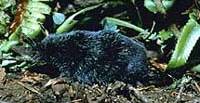- Shrew-mole
Taxobox
name = Shrew-moleMSW3 Hutterer | pages = 303-304]
status = LR/lc
status_system = iucn2.3
status_Ref = IUCN2006 | assessors = Insectivore Specialist Group | year = 1996 | id = 41468 | title = Neurotrichus gibbsii | downloaded =2006-05-12 Database entry includes a brief justification of why this species is of least concern]

regnum =Animal ia
phylum =Chordata
classis =Mammal ia
ordo =Soricomorpha
familia =Talpidae
subfamilia =Talpinae
tribus = Neutrichini
tribus_authority = Hutterer, 2005
genus = "Neurotrichus"
genus_authority = Günther, 1880
species = "N. gibbsii"
binomial = "Neurotrichus gibbsii"
binomial_authority = (Baird, 1858)The Shrew-mole ("Neurotrichus gibbsii") is the smallestNorth America n mole. It is the only member of the genus "Neurotrichus" and the tribe Neutrichini. It is also known as the American Shrew Mole, but its relationship to the other shrew moles is distant.It is found in damp forested or bushy areas with deep loose soils in the western
United States and southwesternBritish Columbia .It has dark grey fur, a long flattened snout and has a short but thick bristled tail. It is about 10 cm in length including a 3 cm long tail and weighs about 10 g. Its front paws are smaller and do not face outwards from the body as in other
fossorial moles and so are more similar to those ofshrew s. It has 36 teeth.This mole is often active above ground, foraging in leaf litter for earthworms, insects, snails and slugs. It is able to climb bushes. Predators include
owl s,hawk s andmustelid s.Females have litters with 1 to 4 young.
References
Wikimedia Foundation. 2010.
